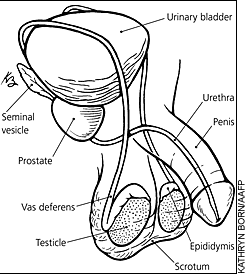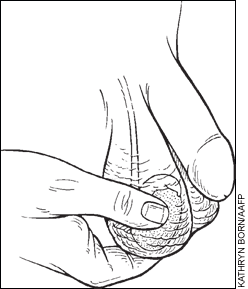
Am Fam Physician. 2008;77(4):475-476
See related article on testicular cancer.
What is testicular cancer and who gets it?
Testicular cancer is cancer that starts in one or both testicles. These are held inside a skin sack called the scrotum (see drawing 1).

Testicular cancer is most common in men 20 to 35 years of age. You are more likely to get it if someone in your family has had it or if you had surgery as a child to fix the position of your testicles.
How do I know if I have testicular cancer?
See your doctor if you have pain in one or both of your testicles, feel a lump in your scrotum, or notice that your scrotum is swollen and red.
Your doctor will ask you about your symptoms and check your scrotum and testicles for lumps. If you have a lump, you may need some tests to see if it is cancer.
How is it treated?
You will need surgery to remove the testicle with the cancer. If the cancer has spread to other parts of your body, you may need monthly exams, radiation, chemotherapy, or more surgery.
Treatment usually works well, especially if your cancer is found before it spreads. Even if the cancer spreads, you have a good chance of being cured.
What should I do after I have been treated?
At first, you may need to see your doctor every month for an exam. Later you will only need exams once a year.
You should also do monthly self-exams. To do a self-exam, place your thumb on top of the testicle and your index and middle fingers underneath it. Roll the testicle between the thumb and fingers several times. Repeat with the other testicle (see drawing 2).

You should see your doctor if you find lumps, hardness, swelling, or other changes during a self-exam.
Where can I find more information?
American Academy of Family Physicians
Web site: https://familydoctor.org
American Cancer Society
National Cancer Institute